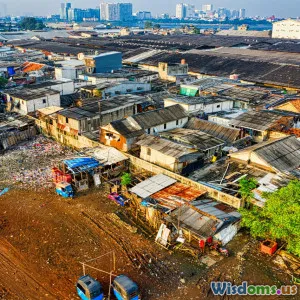
How Economic Instability Fuels Urban Youth Gang Involvement
10 min read An insightful analysis exploring how economic struggles intensify urban youth gang involvement worldwide. (0 Reviews)
How Economic Instability Fuels Urban Youth Gang Involvement
Urban youth gang involvement is a pressing global issue that has captured the attention of policymakers, sociologists, and communities alike. While gangs often gain notoriety through media-focused depictions of violence, the underlying causes are deeply rooted in economic and social realities. Economic instability, in particular, plays an outsized role in shaping the environments that lead young people to join gangs. This article explores the intricate relationship between economic insecurity and gang participation among urban youth, buttressed with real-world examples, data, and expert insights.
Introduction: The Hidden Costs of Economic Instability
Imagine a teenager growing up in a neglected urban neighborhood, where reliable employment is scarce, schools are underfunded, and social services barely reach their doorstep. Economic instability creates fertile ground for despair, frustration, and limited prospects. When conventional opportunities vanish, gang involvement often appears as a viable avenue for economic survival, social connection, and a sense of identity.
Economic instability is not merely about poverty; it encapsulates income volatility, job insecurity, housing instability, and unequal access to resources. As communities grapple with these challenges, youth gangs emerge as an alternative social system, providing members with a form of economic opportunity, protection, and community belonging.
This article aims to unravel how economic hardship specifically fuels urban youth gang involvement and offers insights into preventative strategies.
Understanding Economic Instability and Its Urban Impact
Defining Economic Instability
Economic instability refers to a state in which individuals and households face uncertain income, lack of steady employment, or sudden economic shocks that threaten financial security. Factors that contribute include rising unemployment rates, inflation, shrinking middle classes, and systemic inequalities.
In many urban areas worldwide, especially in post-industrial cities, economic instability manifests through high unemployment, lack of affordable housing, deteriorating infrastructure, and diminished educational chances. According to the U.S. Bureau of Labor Statistics, youth unemployment rates in some metropolitan areas may exceed 20%, significantly higher than the national average.
The Urban Context
Urban areas intensify economic challenges for youth because of population density, overcrowded schools, and limited social capital. A 2022 report by the World Bank highlights that nearly 60% of youth in impoverished urban centers in developing countries are neither employed nor enrolled in education or training, commonly referred to as NEETs.
Such environments magnify feelings of marginalization and economic desperation, catalyzing social dynamics that foster gang affiliations.
Economic Instability as a Driver of Gang Involvement
1. Economic Desperation and Alternative Income
One of the most explicit connections between economic instability and gang involvement is the pursuit of income. Traditional job markets often exclude many urban youths due to lack of skills, education, or discrimination.
Gangs offer an alternative — albeit illegal — economy through activities such as drug trafficking, theft, or fraud. Reports from the National Youth Gang Survey (2019) in the U.S. indicate that about 46% of youth gang members cite financial motivations as their primary reason for joining.
Example: In Chicago's South Side, decades of deindustrialization led to significant job loss among blue-collar workers, decimating legitimate earnings opportunities for youth. Here, gangs have thrived partly by filling economic voids, offering money to disenfranchised youth that legitimate sectors fail to provide.
2. Search for Identity and Social Capital
Economic instability often strips youths of social status and hope for advancement. Gangs can fulfill psychological and social needs by offering members a sense of purpose, identity, and family.
As per Dr. Malcolm Klein, a prominent sociologist studying gangs, “Gangs offer affordances beyond money: loyalty, protection, and belonging that the mainstream economy has denied.”
Through ritual, colors, or territory, youth gain social capital and recognition otherwise inaccessible in unstable economic contexts.
3. Impact of Family Economic Stress
Economic hardship in families contributes indirectly but powerfully to gang involvement. Parents facing unemployment or unstable incomes may struggle to provide supervision, access to enrichment activities, or safe environments.
Research from the Urban Institute (2021) showed that youths from families experiencing chronic economic stress were 2.5 times more likely to join gangs compared to peers in more stable circumstances.
4. Educational Disparities Linked to Economic Struggles
Under-resourced schools in economically unstable neighborhoods lack critical support programs, counseling, and extracurriculars. This educational neglect fosters disengagement, dropping out, and vulnerability to gang recruitment.
For instance, in Barcelona, Spain, youth in low-income metropolitan districts have exhibited higher gang membership rates correlated with poor school performance and limited job-training facilities.
Real-World Case Studies
Case Study 1: Economic Decline and Gang Proliferation in Detroit, USA
Detroit suffered economic ruin due to the collapse of the auto industry. With unemployment soaring to double digits for years, neighborhoods like East Detroit experienced rampant gang activity.
Economic research there found that each 1% increase in unemployment corresponded with a 5% increase in youth gang prevalence. The absence of legitimate economic pathways pushed youth toward gangs where income and identity could be claimed.
Case Study 2: The Favelas of Rio de Janeiro, Brazil
In Rio, economic disparity has transformed favelas into breeding grounds for youth gangs driven by drug economy profits. Limited government presence and inadequate social investments perpetuate cycles where economic instability fuels gang control over entire neighborhoods.
According to a 2020 study in "Crime, Law and Social Change," youth gang recruitment spikes after economic recessions, demonstrating the macroeconomic influence on micro-level gang dynamics.
Breaking the Cycle: Prevention and Policy Implications
1. Economic Investment and Job Programs
Evidence from cities like Medellín, Colombia points to the power of inclusive economic development. When investment surged in youth employment, training, and entrepreneurship, gang membership rates declined notably.
Programs like “Urban Youth Fund” by the UN provide microfinance and mentorship tailored to at-risk youth, turning economic instability into opportunity.
2. Education and Vocational Training
Offering quality, context-sensitive education and skill training is vital. For urban youth, alternatives that engage them meaningfully—particularly in tech, trades, and arts—can counteract gang appeal.
In Sweden's Malmö, accelerated vocational programs for marginalized youth correlated with a 30% reduction in gang recruitment over five years.
3. Strengthening Families and Community Structures
Economic support to families through cash transfers, counseling, and social work reduces stressors that contribute to youth gang involvement.
Community centers providing safe spaces and mentorship can substitute for what gangs offer in terms of social belonging.
Conclusion: Toward Understanding and Action
The nexus between economic instability and urban youth gang involvement is both complex and urgent. These gangs do not simply represent criminal entities; they are symptoms of broader economic and social failings.
Addressing this issue requires more than law enforcement—it demands multifaceted investment in economic security, education, familial stability, and community cohesion.
As urban centers continue to grow and economies fluctuate, understanding and mitigating the economic drivers behind gang involvement becomes crucial. It's not only a matter of public safety but also a step towards social justice and equitable urban development.
By integrating economic opportunity and nurturing social environments, we can help urban youth envision viable futures beyond gangs—because economic instability should never decide a child's destiny.
References
- National Youth Gang Survey, (2019). Centers for Disease Control and Prevention.
- World Bank report on Urban Youth NEETs, (2022).
- Urban Institute, Family Economic Stress Study, (2021).
- Klein, M. (2018). "Gang Membership and Identity." Journal of Youth Development.
- "Crime, Law and Social Change," 2020. Economic Influence on Gang Dynamics.
- UN Urban Youth Fund Program Data, (2023).
- City of Malmö Vocational Programs Evaluation Report, (2021).
- U.S. Bureau of Labor Statistics Reports on Youth Unemployment.
Rate the Post
User Reviews
Other posts in Crime and Society
Popular Posts

















